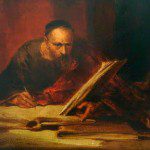Last week was insane, and I didn’t get a post up. Today I’m trying and failing to catch up, so my offering this week is meager.
First, a PSA. Someone asked me a question about the Amazon support links I post at the bottom. They had clicked on it and gone to Amazon looking for a special tick box or option that said “Benjamin the Scribe,” because that’s how some of Amazon’s other programs work. I’m part of the Amazon Associates program, which means that there’s nothing special you need to click except oen of my links. Simply getting to Amazon from any of my Amazon links tells Amazon “this link is from Ben the Scribe.” So whatever you buy through there benefits me a small bit, and it’s greatly appreciated.
Second, if you haven’t listened to Elder Ballard’s address to Seminary and Institute, you really really should (link). It’s fantastic, and I have a lot of thoughts and notes about it and some related issues, but no time to get it up. Maybe this week.
Today, we come to the dreaded Isaiah chapters. I offer a few brief thoughts and resources.
Given how valuable the text of Isaiah is to Nephi, it is a very practical decision for him to make a second (partial) copy, by inscribing it onto his small plates. After all, they only had one solid one.
Nephi has earlier told us why he quotes Isaiah and what he’s doing with it, in 1Ne 19:23; “that I might more fully persuade them to believe in the Lord their Redeemer I did read unto them that which was written by the prophet Isaiah; for I did liken all scriptures unto us, that it might be for our profit and learning”
Nephi’s announcement, among other things, tell us that he’s going to give us a non-contextual application of Isaiah to his people. He is reinterpreting and adapting Isaiah to speak to and about his people, making it relevant for them this way. He is not giving us a historical or contextual interpretation of Isaiah, or what Isaiah really meant when he spoke to the eighth-century Israelites two hundred years earlier. When my students have trouble grasping this point, the following dialogue often helps.
Allowing for a little Semitic hyperbole, were ‘all scriptures’ written for or about the Nephites? Was Leviticus written with the Nephites in mind? Psalms? Jeremiah? And yet, Nephi says he likened all of them to his people. That suggests Nephi both recognizes and is announcing to us that he’s applying these passages in a new way that they hadn’t been written for, and that Isaiah’s primary subject and audience in those chapters was not Nephi’s people. Nephi’s prophetic reading is a creative adaptive one.
Before quoting Isaiah, Nephi also invites the reader of the plates to re-reapply them. “Now these are the words [of Isaiah], and ye may liken them unto you and unto all men. (2Ne 11:8) Nephi’s conception of likening clearly envisioned a reinterpretive flexibility, wherein everyone could see themselves in Isaiah somehow.
Elder McConkie (no milquetoast liberal) approved of this idea, that later interpreters like Nephi and the New Testament authors are re-interpreting, giving new meaning to something. Nephi, he said, “gave, not a literal, but an inspired and interpreting translation. And in many instances his words give either a new or greatly expanded meaning to the original prophetic word.” (My emphasis, original here.)
We shouldn’t expect Nephi’s understanding of Isaiah to reflect what Isaiah meant to Isaiah’s first hearers c. 740BC nor to Jerusalem Israelites contemporary with Nephi. For more on contextual vs. non-contextual intepretation, see my post here on Isaiah 22. (I feel like I’ve talked about this a lot, but can’t recall my other posts about it.)
I think the best single paper on these chapters and Nephi’s interpretation and what it might have meant to the Nephites is by Gee and Roper, LINK
Two more resources that may be useful are
- Visualizing Isaiah, a free pdf from the Maxwell Institute. It looks like you have to download individual chapters, but if you want to see images of people, places, and things that Isaiah mentions, visuals for your class or kids, this is a good resource.
- Isaiah in the Book of Mormon, another free Pdf from the Maxwell Institute of a hardcover volume.
Nephi quotes Isaiah 2-14, so there’s not a lot of overlap with our Isaiah lessons from last year, but here’s my intro and Isaiah 1-6.
As always, you can support my work through making your regular Amazon purchases through this Amazon link. Or you can donate directly here.
You can also get updates by email whenever a post goes up (subscription box on the right). If you friend me on Facebook, please drop me a note telling me you’re a reader. I tend not to accept friend requests from people I’m not acquainted with.











